Developer/Manufacturer: General Dynamics' Electric Boat Corporation, Groton, Connecticut; and
Newport News Shipbuilding, Newport News, Virginia.
Surface Ships, Craft & Logistics Systems
COLDS
Cargo Offload and Discharge System
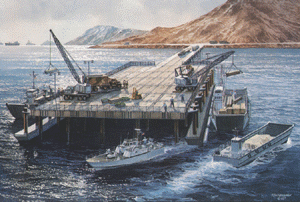
Description: The Cargo Offload and Discharge System (COLDS) includes the Cargo Offload and
Transfer System (COTS) for dry cargo and the Offshore Petroleum Discharge System (OPDS) for
liquid cargo. COLDS supports Logistics-Over-The-Shore (LOTS) operations loading and
unloading of Marine Corps Maritime Prepositioning Force (MPF) and Assault Follow-On Echelon
(AFOE) ships without benefit of established port facilities. Routine replacement of these heavily
used assets maintains LOTS readiness.
Program Status: Current research and development efforts to provide a Sea-State-Three
operational LOTS capability include an Advanced Concept Technology Demonstration (ACTD) for
lighterage, multiple projects for shipboard cranes, and various critical elements of the LOTS
system of systems. The contract for next-generation sea-state-three lighterage will be awarded in
FY 2000 following the ACTD. The completed 3,000-foot modular Elevated Causeway [ELCAS(M)]
was delivered in early FY 1998.
Developer/Manufacturer: ELCAS(M): JERED Brown Brothers, Brunswick, Georgia. Non-powered
causeways: Metal Trades, Charleston, South Carolina.
CG-47 Ticonderoga Class
Aegis Guided Missile Cruiser Conversion Program

Description: The 27 CG-47 class guided missile cruisers have combat systems centered around the Aegis Weapon System and the SPY-1 multi-function, phased-array radar. The Ticonderoga class' combat system includes the Standard Missile (SM-2), unparalleled air warfare systems, advanced anti-submarine warfare systems, embarked sea-control helicopters, and robust command-control-and-communications systems in a potent, multi-mission (ASW, AAW, and
ASUW) ship. In addition, 22 of the 27 cruisers are equipped with the Mk 41 Vertical Launching
System (VLS), giving them a significant land-attack/strike capability with the Tomahawk Land-
Attack cruise Missile (TLAM). Ticonderoga-class cruisers provide multi-mission offensive and
defensive capabilities, and can operate independently or as part of carrier battle groups, surface
action groups, amphibious ready groups, and underway replenishment groups. Beginning in FY
2004, after incorporating new mission capabilities as part of the Cruiser Conversion Program,
these ships will also provide area defense against ballistic missiles, as well as land-attack and
area air-defense commander capability.
Program Status: The Cruiser Conversion Program is a mid-life warfighting capability upgrade for
the Navy's Aegis guided missile cruisers. The Cruiser Conversion Program enables the Navy's
deployment of Theater Ballistic Missile Defense (TBMD), Land Attack in support of the Marine
Corps' concept of Operational Maneuver from the Sea (OMFTS), and Area Air Defense
Commander (AADC) capability. The Cruiser Conversion improvements in warfighting capability
will extend the Aegis combat system's relevancy well into the 21st century. Twenty-two
Ticonderoga Aegis cruisers are planned for conversion beginning in FY 2004.
Developer/Manufacturer: Ingalls Shipbuilding, Pascagoula, Mississippi, and Lockheed Martin,
Moorestown, New Jersey.
CVN-68 Nimitz Class and CVNX
Nuclear-Powered Aircraft Carrier
Description: Nimitz (CVN-68)-class nuclear-powered aircraft carriers are replacing the Navy's aging conventionally powered (oil-fired) carriers on a one-for-one basis, preserving and recapitalizing aircraft carrier battle group (CVBG) force levels to meet forward-presence, crisis-
response, and warfighting requirements. The mission of the CVN-68-class aircraft carriers is to
support and operate aircraft that engage in attack, surveillance, and electronic warfare against
targets at sea, in the air, or ashore in support of Marines or joint forces. America's 12 carriers are
forward-deployed world wide in support of U.S. strategy and commitments and are increasingly
important as the Navy adjusts its emphasis toward littoral regions and land-based forces are
brought home to the United States.
Since the mid/late-1960s when the baseline Nimitz design was finalized, the Navy's carrier force has not had the advantage of an aggressive and robust research and development program to
insert leading-edge technologies and systems into subsequent hulls. For this reason, and to
ensure that the carrier/naval aviation force can meet the daunting operational requirements of the
next century, in 1993 the Navy established a future sea-based air platforms working group to
investigate the requirements, available technologies and systems, and needed R&D to ensure
that a new class of aircraft carriers could capture elements of the incipient Revolutions in Military
and Business Affairs. Based upon these initial studies, the Navy established an approach and
program to develop a revolutionary-design next-generation nuclear carrier, CVNX, to reach the
fleet in 2013, in time to replace the nation's first nuclear-powered carrier,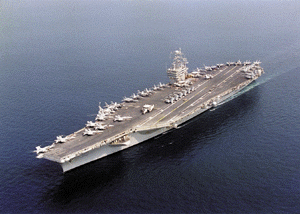 USS Enterprise (CVN-65), as that ship reaches 52 years of age. Fiscal reality, however, resulted in the Navy modifying its approach to the CVNX in mid-1998. Instead of the one-step revolutionary leap from a modified-repeat Nimitz design (CVN-77) to a radically different CVNX, the Navy decided to focus on an evolutionary program that will incorporate warfighting improvements and acquisition, operations, and support cost-saving measures at an affordable pace, over three consecutive hulls beginning with CVN-77. Initial investments will be made in an advanced nuclear plant and electrical distribution system for CVN-77, which will be carried forward, along with other
improvements, into the CVNX-1 and follow-on carriers. Despite the modification to the overall
plan, the principal design objectives for the CVNX class remain intact: to reduce total ownership
costs significantly during each carrier's 50-year service life and to provide a flexible infrastructure
that will facilitate the insertion of new warfighting capabilities as they evolve.
USS Enterprise (CVN-65), as that ship reaches 52 years of age. Fiscal reality, however, resulted in the Navy modifying its approach to the CVNX in mid-1998. Instead of the one-step revolutionary leap from a modified-repeat Nimitz design (CVN-77) to a radically different CVNX, the Navy decided to focus on an evolutionary program that will incorporate warfighting improvements and acquisition, operations, and support cost-saving measures at an affordable pace, over three consecutive hulls beginning with CVN-77. Initial investments will be made in an advanced nuclear plant and electrical distribution system for CVN-77, which will be carried forward, along with other
improvements, into the CVNX-1 and follow-on carriers. Despite the modification to the overall
plan, the principal design objectives for the CVNX class remain intact: to reduce total ownership
costs significantly during each carrier's 50-year service life and to provide a flexible infrastructure
that will facilitate the insertion of new warfighting capabilities as they evolve.
Program Status: Eight Nimitz-class carriers have been delivered through 1998; Ronald Reagan
(CVN-76) is currently under construction and is scheduled to deliver in FY 2002. The President's
FY 2000-2005 Future Years Defense Plan includes funding for CVN-77, a modified-repeat of the
CVN-76, to replace the USS Kitty Hawk (CV-63) in 2008. A multi-year research and development
program is also underway for CVNX, the first unit of which could be requested in FY 2006 for an
FY 2013 delivery to replace the USS Enterprise and sustain minimum essential carrier force
levels. Follow-on, evolutionary-enhanced CVNXs are planned for construction starts at roughly
five-year intervals beyond 2006.
Developer/Manufacturer: Newport News Shipbuilding, Newport News, Virginia.
DD-21 Land-Attack Destroyer
Description: The Land-Attack Destroyer (DD-21) is the first surface combatant founded entirely upon post-Cold War thinking and strategic concepts. Accordingly, the DD-21 design concept will support joint-service requirements in littoral regions. Armed with an array of land-attack weapons,
DD-21 will provide sustained, offensive, distributed, and precise firepower at long ranges in
support of forces ashore. With state-of-the-art information technologies, DD-21 will operate
seamlessly with other naval, ground, and land-based air forces, and will be in accordance with
the Navy's evolving �Network-Centric Warfare� concept of operations and IT21 (Information
Technology for the 21st Century) architecture. The DD-21 emphasis on �sensor-to-shooter�
connectivity will provide a naval or Joint Task Force commander with the multi-mission flexibility
to destroy a wide variety of land targets while simultaneously countering maritime threats.
Moreover, DD-21 will take advantage of advanced stealth features to make these warships less
detectable to potential adversaries and more survivable to enemy attack.
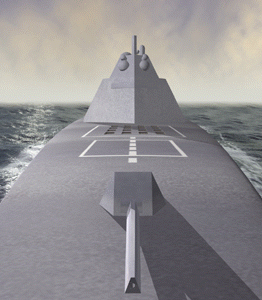
The innovative DD-21 acquisition strategy calls for industry to propose independent designs that
meet the challenging operational requirements and aggressive affordability goals. Since the Navy
is specifying capabilities rather than specific systems, the exact configuration for DD-21 has yet to
be determined. Nevertheless, the combat capa bility of DD-21 will include a mix of sensors and
weapons appropriate for a 21st century multi-mission surface warship. DD-21 will push the
envelope in improved joint connectivity, advanced computing systems, reduced signatures (radar
cross section, infrared, acoustic, magnetic, and active signature management techniques), and
reduced manning. In addition to specifying a crew size objective of 95, the DD-21 Program Office
(PMS-500) is also aggressively engaged in identifying cost efficiencies in related shore-based
and at-sea infrastructures. DD-21 has a procurement cost objective of $750 million (for the fifth
ship in each shipyard in FY 1996 dollars) and an operating and (O&S) cost objective of $2,700
(FY 1996) per hour underway (about one-third the O&S cost of a conventional surface
combatant). DD-21 represents a measured revolution in surface combatant design and
acquisition.
Program Status: While ultimately responsible for acquiring a �family� of next-generation surface
combatants for the 21st Century (SC-21), the DD-21 Program Executive Office (PEO DD-21) will
initially concentrate on design of a new Land-Attack Destroyer. On 12 January 1998, the Under
Secretary of Defense for Acquisition and Technology signed an Acquisition Decision
Memorandum, approving Program Definition and Risk Reduction (Phase I) for DD-21. The ADM
signing signified the formal establishment of this new warship program and marked the beginning
of a new era in surface combatant design and naval warfare capability. In August 1998, the Navy
awarded an agreement to two competing industry teams to conduct requirements analyses and
trade-off studies and to develop initial system concept designs. Down-selection to a single design
and �Full Service Contractor� is planned for 2001. Beginning with lead ship award in 2004, the
Navy plans to acquire 32 DD-21s at a rate of three ships per year, each with an expected service
life of 35 years. The DD-21s will enter the Fleet as the Spruance (DD-963)-class destroyers (31
ships commissioned from 1975 to 1983) and the Oliver Hazard Perry (FFG-7)-class frigates (51
ships commissioned from 1977 to 1989) retire, sustaining the 116-ship surface combatant force
level validated by the 1997 Quadrennial Defense Review.
Developer/Manufacturer: To be determined.
DDG-51 Arleigh Burke Class
Aegis Guided Missile Destroyer
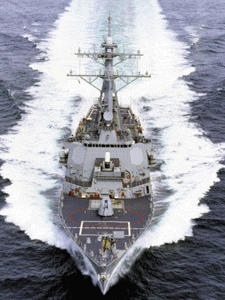
Description: The state-of-the-art DDG-51 guided missile destroyers have combat systems
centered around the Aegis Weapon System and the SPY-1D multi-function, phased-array radar.
Arleigh Burke's combat system includes the Mk 41 Vertical Launching System (VLS), an
advanced anti-submarine warfare system, advanced anti-air warfare missiles, and Tomahawk
cruise missiles in a potent, multi-mission (ASW, AAW, ASUW, and Strike) platform. These ships
will also provide future land-attack capability, as well as area-wide defense against ballistic and
overland cruise missiles. Incorporating all-steel construction and gas-turbine propulsion, Arleigh Burke destroyers provide multi-mission offensive and defensive capabilities, and can operate
independently or as part of carrier battle groups, surface action groups, amphibious ready groups,
and underway replenishment groups. The Flight IIA variant incorporates facilities to support two
embarked helicopters, significantly enhancing the ship's sea-control capabilities.
Program Status: 25 Arleigh Burke-class destroyers have been delivered through FY 1998 and 20
others are under contract and in various stages of construction, with additional ships programmed
for future years. The class will total 57 ships. The first Flight IIA destroyer, Oscar Austin (DDG-
79), was launched in early FY 1999. A multi-year procurement of 12 ships in FY 1998 through
2001 was approved by Congress, which saves $1.4 billion compared to a conventional
acquisition strategy. Four DDGs were approved in FY 1998, and the Navy has requested three
more in FY 1999. The SPY-1D(V), an upgrade to the SPY-1 family of radars, successfully
underwent the first phase of testing in 1996. This improved radar will keep these ships ahead of
the emerging low-observable anti-ship cruise missile threat in the cluttered littoral operating
environment.
Developer/Manufacturer: Bath Iron Works, Bath, Maine; Ingalls Shipbuilding, Pascagoula,
Mississippi; and Lockheed Martin, Moorestown, New Jersey.
LCAC
Landing Craft, Air Cushion
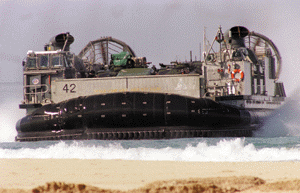
Description: This high-speed, fully amphibious landing craft is capable of carrying a 60-ton payload (75 tons in overload) at speeds in excess of 40 knots with a nominal range of 200
nautical miles. Its ability to ride on a cushion of air allows it to operate directly from the well decks
of amphibious warships. Carrying equipment, troops, and supplies, the LCAC launches from the
well deck, transits at high speed, traverses the surf zone and lands at a suitable place ashore
where it quickly offloads and returns to amphibious shipping for follow-on sorties. LCACs provide
amphibious task force commanders flexibility in selecting landing sites. LCACs permit access to
more than 70% of the world's beaches as compared with 17% for conventional landing craft.
Additionally, LCACs deliver vehicles and cargo directly onto dry land rather than in the surf zone
as is the case with conventional landing craft in some circumstances. LCACs are multi-mission
craft which can conduct assault lane breaching, shallow-water mine countermeasures and
logistics support.
Program Status: Initial Operational Capability was achieved in 1986. Contracts for 91 LCACs
were approved through FY 1997, with 90 craft delivered to the Fleet by the end of 1998.
Delivery of LCAC 91 is scheduled for FY 1999. A Service Life Extension Program will begin in FY
2000 and will extend the LCAC's operational life from 20 years to 30 years.
Developer/Manufacturer: Textron Marine and Land Systems, New Orleans, Louisiana.
LHD-1 Wasp Class
Amphibious Assault Ship
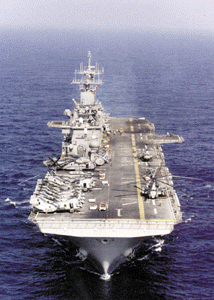
Description: The Wasp (LHD-1) class is a multi-purpose amphibious assault ship whose primary
mission is to provide embarked commanders with requisite command and control capabilities for
amphibious operations and to employ elements of a landing force through a combination of
helicopters, landing craft, or amphibious vehicles. The LHD class has a secondary mission of sea
control. Amphibious forces are the centerpiece of a balanced naval expeditionary capability and
provide rapid power projection ashore. These capabilities are significantly enhanced by the LHD.
The Wasp class increases total lift capacity by providing both a flight deck for helicopters and
Vertical/Short Take-Off or Landing aircraft, such as the AV-8B Harrier and the V-22 Osprey, and a well deck for both air-cushioned and conventional landing craft.
Program Status: Six ships have been delivered to the Fleet, and one additional ship, Iwo Jima
(LHD-7), is scheduled to be delivered in late 2000.
Developer/Manufacturer: Ingalls Shipbuilding, Pascagoula, Mississippi.
LMSR
Large Medium-Speed Roll-On/Roll-Off Ship
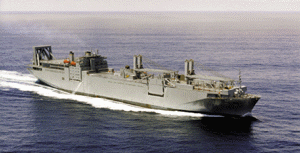
Description: The 1992 Department of Defense Mobility Requirements Study (MRS) defined the
requirements for the LMSR program, which were revalidated in the MRS Bottom-Up Review of 28
March 1995. Nineteen LMSR Sealift Ships are being acquired: five through conversions of
container ships to RO/ROs and 14 through new construction. LMSRs will provide the Army with
eight ships for afloat prepositioning of a heavy brigade's equipment and combat support, and 11
ships for a heavy division's surge equipment from the United States. Each RO/RO ship will carry
about 300,000 square feet of equipment and vehicles at a sustained speed of 24 knots.
Program Status: The five conversions have been delivered. New-construction contracts have
been awarded to two shipyards for one lead ship and options for six additional ships at each yard.
The first new-construction ship delivered in June 1998 and the last is scheduled for delivery in FY
2001.
Developer/Manufacturer: Conversions: National Steel and Shipbuilding Company, San Diego,
California (3); and Newport News Shipbuilding and Dry Dock Company, Newport News, Virginia
(2). New construction: Avondale Industries, New Orleans, Louisiana; and NASSCO, San Diego.
LPD-17 San Antonio Class
Amphibious Transport Dock Ship

Description: The LPD-17 is an amphibious transport dock ship optimized for operational flexibility
and designed to meet Marine Air-Ground Task Force (MAGTF) lift requirements in the emerging
Operational Maneuver from the Sea and Ship-to-Objective Maneuver concepts of operations. The
LPD-17 is a medium-size (approximately 25,300 tons full load), medium-speed (greater than 20
knots, sustained) diesel-powered ship (four turbocharged diesels, two shafts, two outboard
rotating fixed-pitch propellers), of 682 feet in length, with a beam of 105 feet, and a crew of about
363. The LPD-17 will carry approximately 720 troops, and will have 25,000 square feet of space
for vehicles, 36,000 cubic feet of cargo space, medical facilities (24 beds, two operating rooms),
aviation facilities (�O�-level maintenance for three CH-46 helicopters or accommodate a mix of
AH-1/UH-1, CH-46, and CH-53E helicopters and MV-22 Osprey tilt-rotor aircraft), and two landing
craft air cushion (LCAC) vehicles. The 12 LPD-17s in the current program will provide the
functional replacement for 36 aging amphibious lift ships. With the seven Wasp (LHD-1) class,
five Tarawa (LHA-1)-class amphibious assault ships, and the 12 LPDs, the Navy will have the
foundation for meeting the assault-echelon lift requirements of 2.5 Marine Expeditionary Brigade
(MEB) equivalents during wartime and sustaining approximately three forward-deployed Marine
Expeditionary Units (MEUs) in peacetime.
Program Status: Initial contract award to design and build the lead ship of the class was awarded
to the Avondale-Bath Alliance in December 1996. A contract award protest was successfully
resolved in April 1997. Initial delivery is expected in FY 2003.
Developer/Manufacturer: Avondale-Bath Alliance (Avondale Industries, New Orleans, Louisiana;
Bath Iron Works, Bath, Maine; Raytheon, San Diego, California; and Intergraph, Huntsville,
Alabama).
MHC-51 Osprey Class
Coastal Mine Hunter
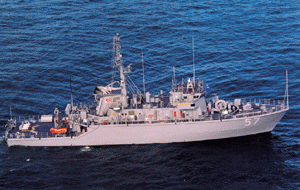
Description: The Osprey (MHC-51)-class coastal mine hunters are an important element of the
U.S. Navy's program to revitalize the nation's mine countermeasures (MCM) force. The modular
Osprey design is based on the glass-reinforced plastic (GRP) hull design of the Italian Lerici-class
MCM ships. The Osprey class incorporates mine-hunting and neutralization equipment
including the advanced SQQ-32 mine-hunting sonar and SLQ-48 Mine Neutralization System
(MNS) and embarked Explosive Ordnance Disposal (EOD) divers. The Navy is modifying the
ships to increase their endurance to 15 days. These ships complement the Navy's 14 Avenger
(MCM-1) multi-mission MCM ships, all of which are in service. (See the Mine Warfare section,
below, for a discussion of the Navy's principal mine warfare programs.)
Program Status: Eleven of the 12 ships in the program have been commissioned through 1998.
Developer/Manufacturer: Intermarine USA, Savannah, Georgia; and Avondale Industries, New
Orleans, Louisiana.
Mk V
Special Operations Craft (SOC)
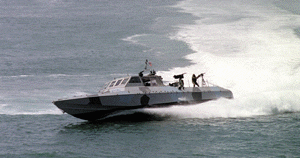
Description: The Mk V is a high-performance combatant craft capable of being transported
overland and on board U.S. Air Force C-5 Galaxy aircraft using its own transporter system. (Mk
Vs can also be transported by surface lift and are compatible with An-124 aircraft.) Mk Vs
primarily support medium-range insertion and extraction of Special Operations Forces (SOF), but
can also support limited coastal patrol and interdiction taskings. The Mk V SOC is 82 feet long
and is powered by two 2,285 horsepower diesel engines driving waterjets, which provide
sustained maximum speeds in excess of 45 knots and unrefueled ranges greater than 500
nautical miles. Armament is tailorable through the selection of multiple crew-served small/minor
caliber weapons (40mm grenade launchers; 12.7mm and 7.62mm single, twin or �gatling�
machine guns; 25mm chain guns and hand-held Stinger surface-to-air missiles) that provide 360
degree coverage. Each craft is operated by a five-man crew and is capable of carrying a Navy
Sea-Air-Land (SEAL) platoon (16 personnel) with four Combat Rubber Raiding Craft (CRRC).
The need for this type of combatant craft was validated during Operations Desert Shield/Storm
and is further justified by potential maritime SOF employments in all unified areas of
responsibility. Twelve Mk Vs will be assigned to Special Boat Squadron One (SBR-1), Coronado,
California, and eight to Special Boat Squadron Two (SBR-2), Little Creek, Virginia. Operational
Mk V detachments comprise two craft, mission support equipment, and eighteen personnel.
Program Status: The Mk V SOCs were acquired under a streamlined acquisition program. Initial
Operational Capability was attained in August 1995 upon delivery of the first two craft. Full-Rate
Production began in FY 1996. Through 1998, 16 of 20 craft have been delivered and are
operational world wide. Final system deliveries are scheduled (for SBR-1) in FY 1999.
Developer/Manufacturer: Halter Marine, Inc., Gulfport, Mississippi.
PC-1 Cyclone Class
Patrol Coastal Craft
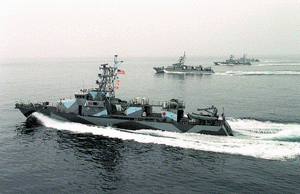
Description: The PC is a commissioned vessel primarily intended for operations in the
littoral/shallow coastal waters. PCs replaced the Navy's Mk III and Mk IV patrol boats (PBs). The
PC is 170.5 feet in length and displaces in excess of 350 tons. The propulsion plant comprises
four 3,600 bhp diesel engines driving four shafts, making a top speed in excess of 35 knots.
Range is greater than 3,000 nautical miles at 12 knots. Manning is four officers and 24 enlisted
personnel, not including embarked Special Operations Forces (SOF) in dedicated berthing
spaces. The PC is armed with hand-held Stinger surface-to-air missiles, two Mk 38 mounts (with
25mm chain guns), several mounts that will accept 12.7mm or 7.62mm machine guns, and/or
40mm grenade launchers. The need for this type of combatant craft was validated during
Operation Earnest Will in the Arabian Gulf in 1987-88, revalidated during Operations Desert
Shield/Storm, and is further justified by potential maritime SOF employment in all unified areas of
responsibility. PCs are unique in that each is a commissioned ship, but operational leadership
and resource sponsorship are provided by the Commander, Naval Special Warfare Command,
the naval component of the U.S. Special Operations Command. PCs conduct and support special
operations missions, including special reconnaissance (coastal patrol), direct action (interdiction),
and foreign internal defense usually in support of a theater commander's peacetime engagement
strategy. Other missions that PCs support include maritime delivery/recovery of SOF, maritime
intercept operations, and deception (usually in support of amphibious operations).
Program Status: The first ship, Cyclone (PC-1), was funded in FY 1990 and entered service in August 1993. Originally, Naval Special Warfare planned to procure a total of 16 PC-1s, but the program was reduced to 13 craft. However, a fourteenth ship is now under construction, with delivery scheduled for FY 2000.
Developer/Manufacturer: Bollinger Shipyards, Houma, Louisiana.
T-AGOS
Ocean Surveillance Ship

Description: T-AGOS ocean surveillance ships are small, civilian-manned auxiliary ships that play
a prominent role in augmenting the Navy's overall anti-submarine warfare (ASW) capability.
There are three classes of this ship: the monohull Stalwart (T-AGOS-1)-class and two twin-hull
classes, the Victorious (T-AGOS-19), known as SWATH-P, and Impeccable (T-AGOS-23), the SWATH-A. These last two classes are Small Waterplane Area Twin-Hull (SWATH) designs that allow the ships to operate in relatively high seas. T-AGOS ships provide a platform for the
Surveillance Towed Array Sensor System (AN/UQQ-2 SURTASS). The T-AGOS is the Navy's
only long-range, mobile, surface ASW platform capable of detecting submarine targets. Although
these ships are part of the Military Sealift Command's Naval Fleet Auxiliary Force (NFAF), they
come under the operational control of fleet commanders.
Program Status: Three T-AGOS ships are in the Fleet as SURTASS platforms as of early 1998. These three ships are augmented by one additional leased commercial vessel, Cory Chouest, equipped with SURTASS as well as a prototype SURTASS Low Frequency Active (LFA) system under development for the SWATH-A class. Eleven T-AGOS monohull ships have transferred to
other federal agencies; and four others are in lay-up with the inactive fleet. Four small (3,500-ton)
SWATH-P ships are in service. One large (5,500-ton) Impeccable-class SWATH-A ship, designed
as a platform for SURTASS Low Frequency Active (LFA), is under contract, and is scheduled to
be delivered in FY 2001.
Developer/Manufacturer: Halter Marine, Inc., Moss Point, Mississippi.
T-AGS-60
Oceanographic Ship
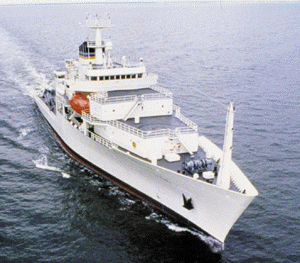
Description: T-AGS-60-class oceanographic ships provide multi-purpose oceanographic survey and data collection capabilities in littoral, coastal, and deep-ocean areas including physical,
chemical, and biological environmental investigations; marine geology and geophysics; and
bathymetric, gravimetric, and magnometric surveying. Typical missions of T-AGS-60 ships
include oceanographic sampling and multi-layer data collection, and the launch, recovery, and
tow of scientific packages, using both tethered and autonomous remotely operated vehicles.
Program Status: These ships are replacements for technically obsolete or single-purpose ships. A total of six ships are planned; four have been delivered from FY 1994 to FY 1998. The fifth, Bruce C. Heezen (T-AGS-64), is scheduled for delivery in December 1999, and a sixth ship (T-AGS-65) is under contract for delivery in December 2001.
Developer/Manufacturer: Halter Marine, Inc., Moss Point, Mississippi.


 Return to the Table of Contents
Return to the Table of Contents
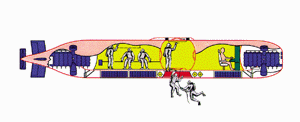

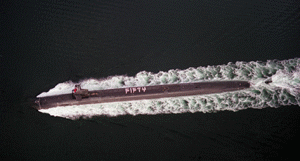
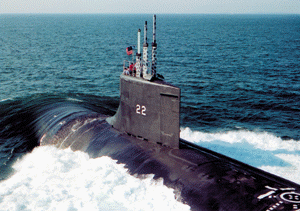



 USS Enterprise (CVN-65), as that ship reaches 52 years of age. Fiscal reality, however, resulted in the Navy modifying its approach to the CVNX in mid-1998. Instead of the one-step revolutionary leap from a modified-repeat Nimitz design (CVN-77) to a radically different CVNX, the Navy decided to focus on an evolutionary program that will incorporate warfighting improvements and acquisition, operations, and support cost-saving measures at an affordable pace, over three consecutive hulls beginning with CVN-77. Initial investments will be made in an advanced nuclear plant and electrical distribution system for CVN-77, which will be carried forward, along with other
improvements, into the CVNX-1 and follow-on carriers. Despite the modification to the overall
plan, the principal design objectives for the CVNX class remain intact: to reduce total ownership
costs significantly during each carrier's 50-year service life and to provide a flexible infrastructure
that will facilitate the insertion of new warfighting capabilities as they evolve.
USS Enterprise (CVN-65), as that ship reaches 52 years of age. Fiscal reality, however, resulted in the Navy modifying its approach to the CVNX in mid-1998. Instead of the one-step revolutionary leap from a modified-repeat Nimitz design (CVN-77) to a radically different CVNX, the Navy decided to focus on an evolutionary program that will incorporate warfighting improvements and acquisition, operations, and support cost-saving measures at an affordable pace, over three consecutive hulls beginning with CVN-77. Initial investments will be made in an advanced nuclear plant and electrical distribution system for CVN-77, which will be carried forward, along with other
improvements, into the CVNX-1 and follow-on carriers. Despite the modification to the overall
plan, the principal design objectives for the CVNX class remain intact: to reduce total ownership
costs significantly during each carrier's 50-year service life and to provide a flexible infrastructure
that will facilitate the insertion of new warfighting capabilities as they evolve.










